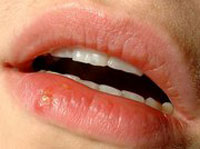Nine misconceptions about herpes
The number of people with the common cold core, usually present on and around the lips, tends to increase as temperatures drop outside. Indeed, oral herpes is quite common. There is no air of mystery about it. However, an average patient does not seem to be very knowledgeable about the disease. “Well, it looks like small blisters occurring on the lips,” one would say. The more initiated (and the former sufferers) would also mention genital herpes. However, just a handful may be aware of a close relationship between the two types of herpes simplex virus (HSV).

Below are some of the most typical myths about oral and genital herpes infections.
Myth No 1: Cold sore is a not contagious disease
On the contrary, herpes simplex virus type 1 (HSV-1) is transmitted by coughing and sneezing. Both HSV-1 and HSV-2 are also transmitted by direct contact (sexual activities, kissing, touching or/and from objects such as shared drinking glasses, lipstick, toothbrushes etc.) The genital herpes infection can pose a particular threat to newborns who may be infected during passage through the birth canal. The risk is particularly high if the mother was infected with HSV-2 during the third trimester of a pregnancy. In this case, the mother’s body lacks protective antibodies that would otherwise reduce virus shedding to the infant.
Myth No 2: Oral herpes infection indicates a cold sore
In actuality, oral herpes infection is an illness caused by herpes simplex virus type 1 or HSV-1. The virus infection usually reactivates in case of hypothermia. Physical and psychological stress, anxiety, and intercurrent upper respiratory viral infections can also cause outbreaks of oral herpes.
Myth No 3: Common cold will soon be gone if oral herpes lesions appear on the lips
A widespread assertion that is fundamentally wrong. The occurrence of cold cores or fever blisters on the lips indicates that a respiratory infection has disrupted the immune system’s ability to keep the disease with the nerve ganglia.
Myth No 4: Herpes infection will be gone for good once lesions heal
It would be great if the story had a happy ending but things are different in case of herpes infections. Both HSV-1 and HSV-2 travel to sensory nerves after initial infection. After reaching their respective sensory nerves, they reside there as life-long, latent viruses. It is impossible to root out the viruses from the body. However, certain measures can be taken to keep the viruses from causing symptomatic disease. It is believed that 95 percent of adults have oral herpes. Though the majority of the carriers become infected at age 3-4, only 20 percent of them will experience recurrent outbreaks of orolabial herpes.
Myth No 5: One may transmit HSV-1 infection only when there is an outbreak of cold sores
In fact, the risk of spreading the virus infection is higher when a cluster of fluid-filled blisters appear once the virus reactivates. However, the virus infection can be transmitted at anymomentthough microscopic injuries to the skin or mucous membranes.
Myth No 6: Oral herpes and genital herpes differ from each other in terms of disease classification. Herpes infections cannot be spread via oral sex.
HSV-1 and HSV-2 are members of the same virus subfamily. HSV-1 or herpes simplex virus type 1 is usually the cause of common non-sexually transmitted cold sores, which can also be spread to genitals though oral sex. Likewise, HSV-2 (usually the cause of genital herpes) can also be spread to the oral area, although the occurrence of this is thought to be quite rare.
Myth No 7: Condoms are completely effective in preventing the spread of genital herpes
Condoms have been shown to be an effective means of decreasing the risk of HSV-2 infection. On the other hand, condoms may not provide complete protection. The virus can be transmitted by skin contact with other unprotected regions of the body. It can also be transmitted if condoms are of poor quality or used inappropriately.
Myth No 8: Cauterizing lesions with a caustic substance e.g. alcohol, iodine is the best way of treating infected area
Using caustic substances on herpes lesions cannot destroy the virus or control herpes outbreaks. At the same time, one can easily burn the affected area of the skin or mucous membrane by using caustic substances. Alcohol-free antiseptics can be used for preventing a potential pustular infection. Prescription antiviral medications such as acyclovir (Zovirax) should be used for controlling herpes outbreaks. Daily multivitamin intake may be beneficial for maintaining immune system health and preventing recurrences.
Myth No 9: Herpes simplex infections are not life-threatening conditions because they affect skin only
In reality, HSV infections are the second most frequent cause of death; a greater number of people are killed only by severe respiratory viral infections with flu leading the charge. Herpes simplex virus incorporates itself in the genome of nerve cells, hence the emergence of painful herpetic sores on the skin in close proximity to nerve endings. Theoretically, herpes lesions may appear in any region which has nerve fibers. In other words, any organ may be at risk. In immunocompromised patients, herpes simplex infection may affect fixed mucosa inside the mouth and larynx; it may also does damage to the cornea and conjunctiva of the eye, lymph nodes, internal sexual organs, intestine, lever, kidneys, lungs and the central nervous system. Most patients with encephalitis or meningitis caused by herpes infecting the brain are likely to succumb to the diseases or remain severely handicapped.
Besides, congenital herpesviral infection may result in multiple development disorders or/and death of the infant. It is thought that the long-term effects of genital herpes may contribute to the risk of cervical cancer in women and prostate cancer in men.
Medportal
Translated by Guerman Grachev
Pravda.ru
Subscribe to Pravda.Ru Telegram channel, Facebook, RSS!




